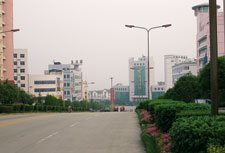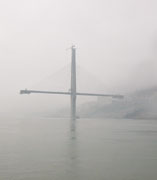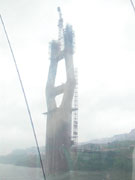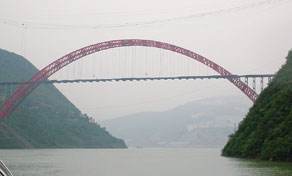 |
| INSTANT TOWN New Zigui, upstream from dam, is becoming a center of commerce and tourism. |
...378 from the state Ministry of Power and Hydrologys Third, Seventh and Eighth Brigades, an effort to push state-run enterprises into a free-market environment.
Super-sized
Nearly every aspect of Three Gorges dwarfs the worlds other big dams. Senior officials hint that the project is on track to finish in 2008 at a cost of $23 billiona year early and $2 billion below the most frequently cited cost estimate. By the time they are done, the Three Gorges team will have excavated more than 102 million cu m of earth, placed nearly 28 million cu m of concrete and installed more than three-quarters of a million tons of rebar and structural steel.
There is every reason for confidence, says Cao Guangjing, CGTPC vice president. "We have hit every one of our milestones for 10 years," he says.
The structure stretches more than 2,300 m across the river, with a crest elevation of 185 m. The centerpiece is a 483-m-long spillway, with 22 sluice gates on the surface and below, at elevation 90 m, 23 bottom outlets to pass sediment.
A total of 26 generators in both powerhouses are designed to provide up to 18,200 MW. But with Chinas appetite for power showing no signs of diminishing, in all likelihood six additional underground units will be built on the right bank, adding an additional 4,200 MW.
 |  |
 | |
| OUT OF THE FOG Sichuan, a backwater province for years, is opening up. Three bridges spanning the Yangtze now are under construction. | |
McCully from IRN and others argue that it makes more sense to build smaller, run-of-river dams further upstream and on the tributaries, where siltation is not as big an issue. The government plans to do that over the next decade with scores of additional hydro projects, but for now, the main focus is on the big blockage on the big river.
During its 6,300-km path from the Tibetan plateau to the East China Sea, the Yangtze moves an average sediment load of more than 170 million cu m annually. Much of it replenishes the fields of Jiangsu Province, Chinas rice bowl on the coastal plain.
But the same floods that nourish the agricultural basin also have exacted a huge price in human life and property. Accurate records are hard to come by, but none deny that the Yangtze has claimed hundreds of thousands of lives in the past century. Mao Zedongs revolutionary land reform and industrialization programs gave birth to modern China, but the delivery was painful.
|
Land reform triggered famines and widespread deforestation. Hillsides stripped bare made severe flooding more frequent. The probability of major Yangtze flooding went from once a century to once a decade. Maos 1950s construction bonanza created 80,000 dams and reservoirs. But design and construction were substandard.
Dam failures became common. A 1973 study found that 45% of 10,000 mid-to-large reservoirs were off-spec and ineffective for flood control.
In Henan Province, an August 1975 typhoon collapsed Banqiao and Shimantan dams. Each had a maximum crest height of more than 100 m. The water resources ministry said more than 20,000 people died, but others placed the figure 10 times higher.
Quality Counts
Against such a tragic history, it is understandable that the Three Gorges Project engineers place a high premium on design studies, hydraulic models and quality control. Ernest Mitchell, now with Bechtel Group but previously with MWH in...

Post a comment to this article
Report Abusive Comment